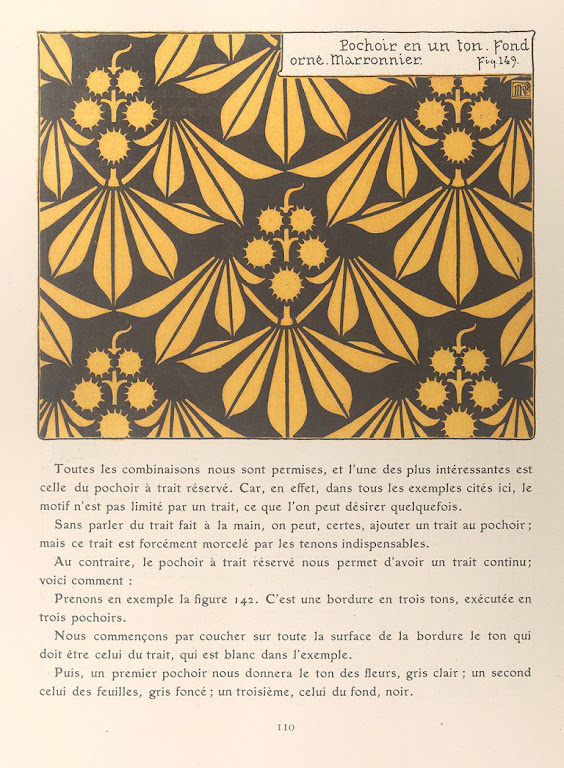Maurice Pillard Verneuil (1869 - 1942) was born in Saint Quentin, France. He learned his trade from the Swiss designer Eugène Grasset (a series on Eugène Grasset can be found in the index of this blog). Verneuil then went on to become a well-known artist and designer. He was inspired by Japanese art and nature, particularly the sea. He is known for his contribution to the Art Deco movement and, in particular, his use of bold, floral designs in ceramic tiles, wallpapers, and other furnishing textiles.
This is part 4 of a 6-part series on the works of Maurice Verneuil.
1903 Etude de la Plante (Study of Plants) continued from part 3:
 |
| Fuchsia stencil border |
 |
| Fuchsia |
 |
| Stencil in one tone. Ornate background. Chestnut tree. |
 |
| Lily seedlings stencil |
 |
| Stencil in one tone. Columbine. |
 |
| Columbine |
 |
| Mimosa border and stencil seedlings |
 |
| Mimosa |
 |
| Stencil in two tones. Ornate poppy background |
 |
| Poppy |
 |
| Poppy details |
 |
| Stencil in one tone Clematis |
 |
| Perce-Niege seedlings stencil |
 |
| Ceramic |
 |
| Apple Tree |
 |
| Tile border. Cyclamen |
 |
| Cyclamen |
 |
| Two tile border. Sunflower |
 |
| Border. Loofah |
 |
| Floor tile Columbine. Floor tile Maple. Pavement Water Lily. Floor tile Cyclamen |
 |
| Small panelling Foxgloves |
 |
| Foxgloves |
 |
| Crown Imperial |
 |
| Crown Imperial |
 |
| Vases. Bindweed, Fritillary, Freesia |
 |
| Brize |
 |
| Three decorated vases |
 |
| Cypripédium roezlii |
 |
| Cypripédium |
 |
| Two decorated vases. Cypripédium and cyclamen |
 |
| Decorated vases |
 |
| Dandelion |
 |
| Campanule |
 |
| Two vases Campanule Butome |
 |
| Leek Soup |
 |
| Leek |
 |
| Apple blossom compote and tray detail |
 |
| Strawberry |
 |
| Green seaweed water jug and bowl |
 |
| Wallpapers and printed fabrics |
 |
| Orchid wallpaper |
 |
| Purple orchid |
 |
| Lily of the Valley necklace wallpaper |
 |
| Lily of the Valley |
 |
| Chinese Spring Necklace |
 |
| Chinese Primrose |
 |
| Eschscholtzia wallpaper |
 |
| Eschscholtzia |
 |
| Freesia |
 |
| Refracted inflorescence freesia |
 |
| Painted wallpaper |
 |
| Stramoine or thorny apple |
 |
| Stramoine or thorny apple wallpaper |
 |
| Stramoine flower and seed details |
 |
| Stramoine leaf detail |
 |
| Water lily and Sagittarius wallpaper |
Etude de la Plante (Study of Plants) continues in part 5.
No comments:
Post a Comment
Note: only a member of this blog may post a comment.